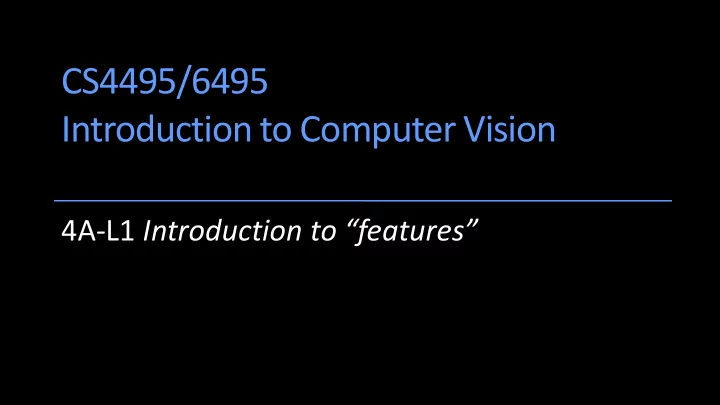

CS4495/6495 Introduction to Computer Vision 4A-L1 Introduction to “features”
Text resources • Forsyth and Ponce: 5.3-5.4 • Szeliski also covers this well – Section 4 – 4.1.1
The basic image point matching problem • Suppose I have two images related by some transformation. Or have two images of the same object in different positions. • How to find the transformation of image 1 that would align it with image 2?
We want Local (1 ) Features (2 ) • Goal: Find points in an image that can be: • Found in other images • Found precisely – well localized • Found reliably – well matched
We want Local (1 ) Features (2 ) Why? • Want to compute a fundamental matrix to recover geometry • Robotics/Vision: See how a bunch of points move from one frame to another. Allows computation of how camera moved -> depth -> moving objects • Build a panorama…
Suppose you want to build a panorama M. Brown and D. G. Lowe. Recognising Panoramas. ICCV 2003
How do we build panorama? • We need to match (align) images
Matching with Features • Detect features (feature points) in both images
Matching with Features • Detect features (feature points) in both images • Match features - find corresponding pairs
Matching with Features • Detect features (feature points) in both images • Match features - find corresponding pairs • Use these pairs to align images
Matching with Features • Problem 1: • Detect the same point independently in both images no chance to match! We need a repeatable detector
Matching with Features • Problem 2: • For each point correctly recognize the corresponding one ? We need a reliable and distinctive descriptor
More motivation… • Feature points are used also for: • Image alignment (e.g. homography or fundamental matrix) • 3D reconstruction • Motion tracking • Object recognition • Indexing and database retrieval • Robot navigation • … other
Characteristics of good features
Characteristics of good features Repeatability/Precision • The same feature can be found in several images despite geometric and photometric transformations
Characteristics of good features Saliency/Matchability • Each feature has a distinctive description
Characteristics of good features Compactness and efficiency • Many fewer features than image pixels
Characteristics of good features Locality • A feature occupies a relatively small area of the image; robust to clutter and occlusion
Recommend
More recommend